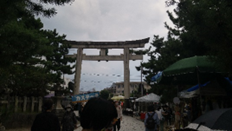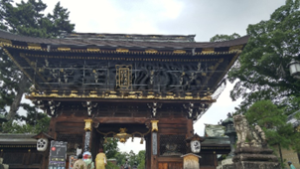Plum season, plum blossoms and plum fruits, Kitano Tenmangu Shrine, the origin of the name of the Reiwa era
Yoshie Doi
 |
 |
Speaking of Tenjin, Kitano Tenmangu is the head shrine of approximately 12,000 Tenmangu and Tenjin shrines nationwide that enshrine Sugawara Michizane.
In the 5th year of Tenkei (942), Tajihino Ayako, who lived in Ukyo Shichijo Shibo, received an order to “enshrine the spirit of Michizane in Kitano Ukon’s riding ground.” A small shrine was built and enshrined there, but in the first year of Tenreki (947), the shrine was relocated to the land of Kitano, which is the heaven gate (northwest) of Heiankyo, and Kitano Tenmangu Shrine was founded.
Tenmon is the opposite of Kimon, and shrines and other things were arranged so that the power of the area could be further enhanced. The idea is that building a shrine there will make the area even more prosperous. On the other hand, Kimon built a shrine to seal off Kimon. Although it is still familiar today, it was a very important way of thinking during the Heian period. Kitano Tenmangu Shrine and Taishogun Hachi Shrine are also Tenmon shrines.
After that, there was a large-scale construction of the shrine by the Fujiwara
clan, and in the first year of Eien (987), an imperial messenger from Emperor Ichijo was dispatched to pray for the peace of the nation. At this time, Emperor Ichijo gave Michizane the title of “Kitano Tenma Daijidaitenjin’, and Michizane was enshrined as “Tenjin-sama”.
In the Tensho era, Toyotomi Hideyoshi held the Kitano Grand Tea Ceremony in the precincts, and in the Keicho era, Izumo Okuni performed Yayako Odori (Kabuki Odori) for the first time in Kyoto. Kitano was also a center of cultural dissemination.
During the Edo period, terakoya, where reading, writing, and abacus were taught, spread throughout the country. This is one of the reasons why it has become widely known to people as the “god of learning” and “the god of performing arts.”
There are many plum trees that Michizane loved in the precincts. The plum blossom festival held on February 25, the anniversary of Shogetsu’s death, envelops the precincts in the faint scent of plum blossoms.
Plum is a flowering tree native to China, and the benefits of plum are described in the oldest Chinese pharmacological book “Shinno Honzokyo” 2000 years ago. Ume is said to have been introduced to Japan around the end of the 3rd century.
In Japanese literature, the character “plum” is mentioned in Japan’s first collection of Chinese poetry, “Kaifuso” (751). In addition, there are many waka poems with the theme of plums in Japan’s oldest collection of poems, “Manyoshu”. At that time, hanami was for plum blossoms.
It was around the middle of the Heian period that the original form of umeboshi, pickled ume, was first described in a book as ‘umeboshi’. It is said that when Emperor Murakami (reigned 946-967) fell ill with a plague, he drank tea with umeboshi and kombu seaweed and recovered. It is inherited as Daifuku tea on New Year’s Day.
2023 is the 5th year of Reiwa, and the name of the Reiwa era is also related to plum blossoms. The name “Reiwa” is derived from the poet Otomo no Tabito in the “Manyoshu”. 「時に、初春の令月にして、気淑(よ)く風和ぎ、梅は鏡前の粉(こ)を披(ひら)き、蘭は珮後(はいご)の香を薫らす」 ”Reiwa” was born from these two characters.
It was a wonderful month of early spring, the wind was as gentle as the cheerfulness of spring, the plum blossoms were blooming like the white powder of a beautiful woman in front of a mirror, and the orchids were fragrant like the incense that adorned her. Is it the arrival of spring that the plum blossoms are in full bloom? In the plum season, We want to enjoy both flowers and fruits.
The end of document
